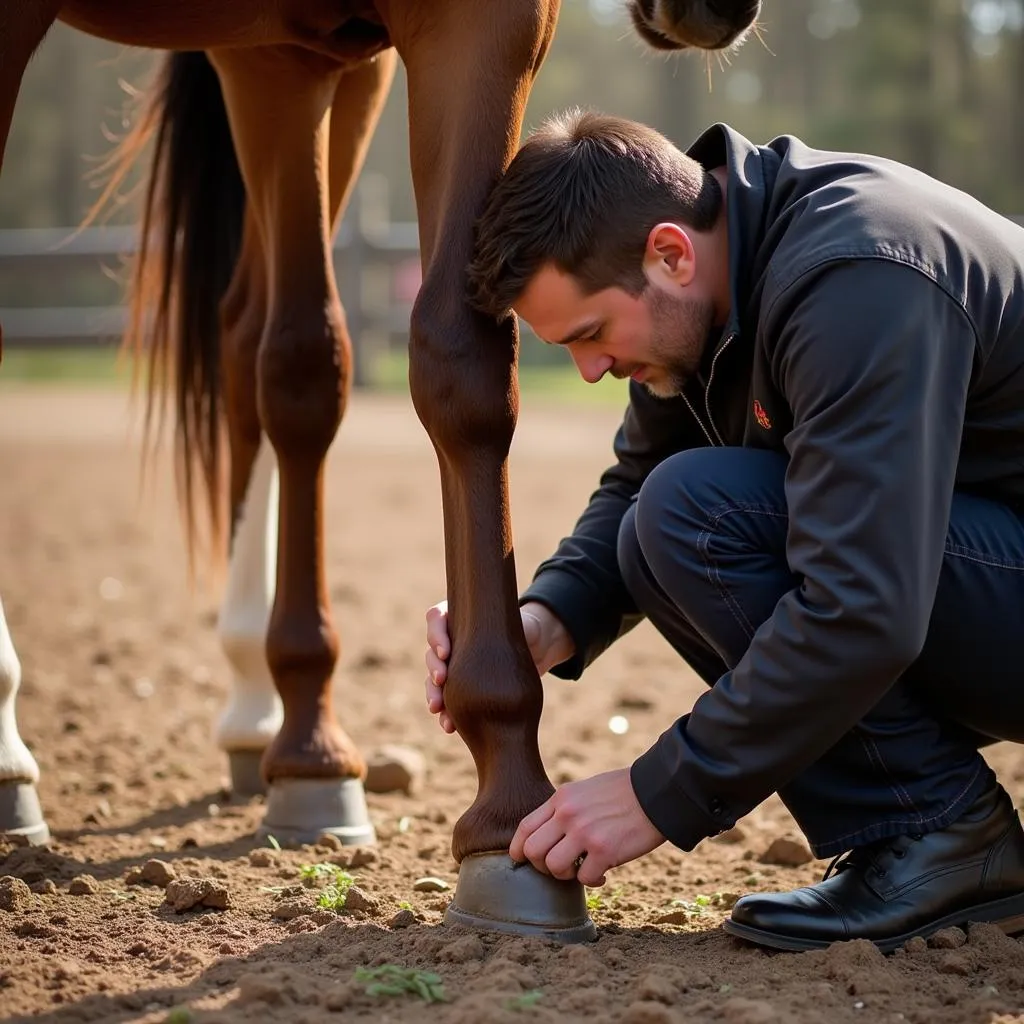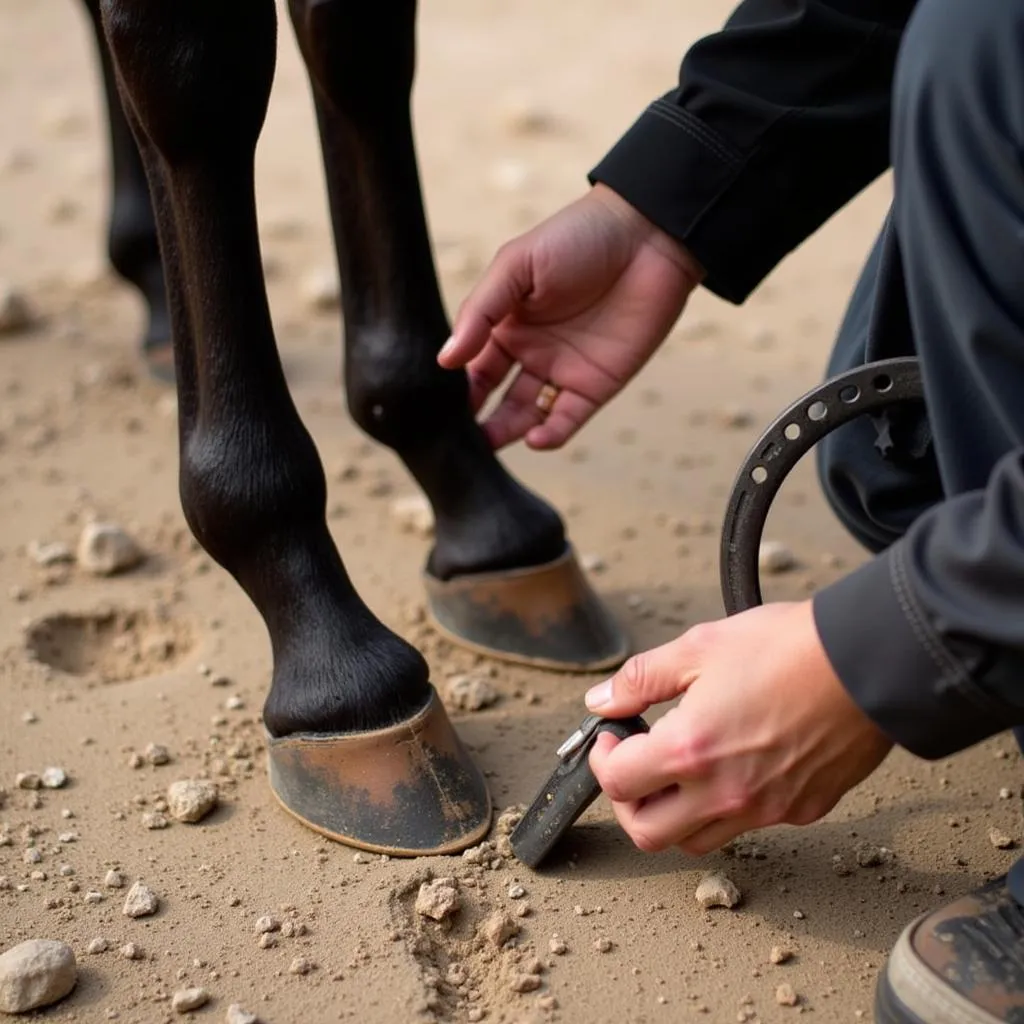Horse Forging is an essential aspect of equine care that ensures the well-being and performance of your horse. It involves shaping and trimming the horse’s hooves to maintain their health and prevent injury. This comprehensive guide will provide you with a deep understanding of horse forging, its benefits, and the importance of finding a skilled farrier.
Understanding Horse Forging
Forging, also known as horseshoeing, is the process of applying horseshoes to a horse’s hooves. Horseshoes are made from various materials, such as steel, aluminum, or plastic, and are designed to protect the hooves from wear and tear, provide traction, and prevent lameness.
Why is Horse Forging Important?
- Protection: Horseshoes act as a protective barrier, preventing the hooves from excessive wear and tear, especially on hard surfaces.
- Traction: Horseshoes provide better traction, especially in slippery conditions, improving their stability and preventing slipping.
- Balance and Support: Proper hoof trimming and shoeing ensure a balanced and supported hoof structure, preventing lameness and promoting optimal movement.
- Corrective Measures: In some cases, horseshoes can be used for corrective purposes, such as treating hoof deformities or correcting gait problems.
The Role of a Farrier
A farrier is a skilled professional who specializes in horseshoeing and hoof care. They are responsible for:
- Trimming and Shaping: Farriers trim and shape the hooves to ensure they are healthy and balanced.
- Applying Horseshoes: They apply horseshoes using specialized techniques to ensure a proper fit and prevent damage to the hoof.
- Assessing Hoof Health: Farriers are trained to identify potential hoof problems and advise on the best course of action.
“A good farrier is like an artist,” says Dr. John Smith, a renowned equine veterinarian. “They work with the horse’s natural structure to create a healthy and balanced hoof that allows for optimal performance.”
Different Types of Horseshoes
There are various types of horseshoes available, each designed for specific purposes:
- Standard Horseshoes: These are the most common type, providing basic protection and support for the hoof.
- Therapeutic Horseshoes: Designed to address specific hoof problems, such as laminitis or hoof rotation.
- Competition Horseshoes: Designed to enhance performance and provide additional support for horses competing in specific disciplines.
- Specialty Horseshoes: These may include shoes with specialized features like studs for traction or pads for cushioning.
The Horse Forging Process
The horse forging process typically involves the following steps:
- Examination: The farrier examines the horse’s hooves, checking for any signs of injury, disease, or abnormalities.
- Trimming: The farrier trims the hooves to a healthy shape and length, ensuring they are balanced and properly supported.
- Shoeing: The farrier applies the horseshoes, ensuring a snug fit and proper application.
- Nail Placement: The farrier places the nails carefully to secure the horseshoe to the hoof wall.
- Final Adjustments: The farrier makes any final adjustments to the horseshoe, ensuring a comfortable and functional fit.
Frequency of Horse Forging
The frequency of horse forging varies depending on the horse’s activity level, hoof growth rate, and individual needs. Generally, horses need shoeing every 6-8 weeks, but this can vary depending on the horse’s individual circumstances.
The Importance of Regular Horse Forging
Regular horse forging is essential for maintaining the health and performance of your horse. Neglecting hoof care can lead to:
- Lameness: Improperly trimmed hooves can lead to imbalances and discomfort, increasing the risk of lameness.
- Hoof Infections: Untrimmed hooves are more prone to bacterial and fungal infections, leading to pain and inflammation.
- Reduced Performance: Horses with unhealthy hooves cannot move as freely or perform at their best.
- Increased Risk of Injury: Horses with damaged or neglected hooves are more likely to experience injuries.
Finding a Skilled Farrier
Choosing the right farrier is crucial for the well-being of your horse. Look for a farrier who:
- Is Certified: A certified farrier has undergone specialized training and meets industry standards.
- Has Experience: A farrier with experience will be able to identify and address hoof problems effectively.
- Communicates Well: A good farrier will explain the process and answer any questions you have.
- Is Trustworthy: Choose a farrier who is dedicated to the health and welfare of your horse.
Horse Forging FAQs
Q: How often should I have my horse’s hooves trimmed?
A: Most horses need their hooves trimmed every 6-8 weeks, but this can vary depending on the horse’s activity level, growth rate, and individual needs.
Q: How do I know if my horse needs a new set of shoes?
A: Signs that your horse needs new shoes include:
- Excessive wear and tear: The shoes may be worn down or have lost their protective layer.
- Loose or missing nails: The shoes may be loose or missing nails, causing them to fall off.
- Uneven hoof growth: The hooves may be growing unevenly, causing imbalance and discomfort.
Q: What is the best way to care for my horse’s hooves between shoeings?
A: Here are some tips for hoof care between shoeings:
- Regular cleaning: Keep the hooves clean and free of dirt and debris.
- Moisture control: Ensure the hooves are not overly dry or wet.
- Daily inspection: Inspect the hooves daily for any signs of injury, disease, or abnormalities.
Q: Are there any natural alternatives to shoeing?
A: While shoeing is the most common practice, there are alternative hoof care methods, such as barefoot trimming and hoof boots, that may be suitable for some horses.
Q: How much does horse forging cost?
A: The cost of horse forging varies depending on the farrier’s experience, the type of shoes used, and the horse’s individual needs. It’s best to consult with a local farrier for an accurate price estimate.
Conclusion
Horse forging is a crucial aspect of responsible horse ownership. By understanding the process, choosing a skilled farrier, and implementing regular hoof care, you can ensure the health, performance, and well-being of your equine companion. Remember that investing in proper hoof care can prevent serious problems down the line and allow your horse to live a happy and healthy life.
 Horse hoof trimming for proper balance and support
Horse hoof trimming for proper balance and support
 Application of a horseshoe to a horse's hoof
Application of a horseshoe to a horse's hoof
If you have any questions or require further guidance, please contact us at:
Phone: 0772127271
Email: [email protected]
Address: QGM2+WX2, Vị Trung, Vị Thuỷ, Hậu Giang, Việt Nam
Our team of experts is available 24/7 to assist you.